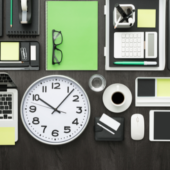We’ve all been there – the times when our to-do list is seemingly endless, and our inbox just keeps filling up. It’s easy to become overwhelmed by emails at times, but by following the 10 simple etiquette tips below, email management can be a breeze.
#1: Keep it Simple
First and foremost, we can ask ourselves if email is the best way to contact or reply to someone given the context. If we anticipate going back and forth quite a bit, or having to include a lot of details, it might be easier to visit with someone in person or pick up the phone. When email is our best option, we should aim to keep our emails as brief and to the point as possible. With so many emails now being read on smartphones and tablets, it is more tedious than ever to scroll through too much content.
#2: Professionalism
We should always be aware of whom we are emailing and always try our best to keep our emails professional in appearance. We should choose a font for our emails that is easy to read, not too big, and that would be standard across most operating systems. We should also aim to do a quick double-check on our spelling and grammar, making sure we use enough punctuation (and not too much – no need for 5 exclamation marks).
#3: Number Our Questions
We often need to ask questions via email. A good way to go about it is to number our questions and make sure they stand out. We can even use a bold font to show our reader that they are important and need an answer. If we don’t number our questions, the reader may skim through the email and not realize that we needed multiple questions answered.
#4: Keeping Work & Personal Emails Separate
If we’re using our work email all day, it can be tempting and easy to add our personal messages to the mix – but mixing work and personal emails is not ideal. First, the many personal emails we will inevitably receive distract us from the work we need to be doing in the first place. Second, most workplaces impose limits on the size of an employee’s inbox, and personal emails take up valuable space needed to file and save important messages. Finally, many personal emails would simply not be viewed as professional in the workplace.
#5: Specify Deadlines
If we need to have someone accomplish something for us by a certain date, we should absolutely let them know in the email. By clearly communicating when we need something done, we enable the other person to be mindful of achieving a task in time. If something is important but doesn’t necessarily have a due date, let the other person know as well, so they can prioritize their workload.
#6: Be Mindful of Attachments
When sending an email with attachments, it’s always good to double-check that we are indeed attaching something and that it is the correct attachment! We should also be mindful that most work emails have size limitations, and those attachments can add up fast. No harm done to ask before sending over a large attachment.
#7: Sparingly Use the ‘Reply All’ Function
Many emails have multiple people involved, whether the message was sent directly to a group or if individuals were copied, or both. In most cases, it is absolutely fine to reply back to the original sender only. There are times when other recipients need to see your response – if it will affect their course of action, or if we are sharing something complimentary to the group – but we should think twice before replying to all, and do so only when necessary.
#8: Vacation Mode
When planning to be out of the office for extended periods of time, we should let others know. In our auto-reply emails, we should clearly define when we will be gone, when we will be returning, and a phone number to contact for urgent needs. If we don’t want anyone to contact us directly, specify an alternate individual and their contact information for the sender of the email while we are away.
#9: Timely Responses
It is very important to be prompt with our responses to emails, for the sake of courtesy and professionalism. During the work week, we should aim to reply back to every email that needs a response within 24 hours; 48 hours should be the absolute maximum we wait to reply back to someone during the working week. If we know that meetings and obligations will delay our email responses, we can even say so in an auto-reply, and that we will respond as soon as possible. That will help the sender by acknowledging that we did in fact receive their email.
#10: Proper Signatures
We should make sure our email signatures look professional and and include sufficient contact information. Email signatures are also a great opportunity to share things like our social media pages, our company website, and any other information we want others to know (without overloading the signature with too much information). Finally, creating a complete email signature for our smartphones will help our messages have a professional feel even when we can’t access our computers.




